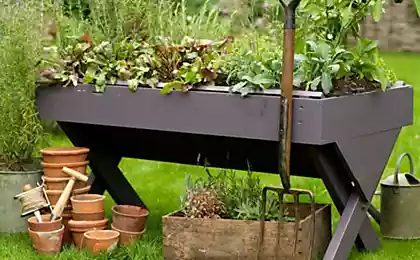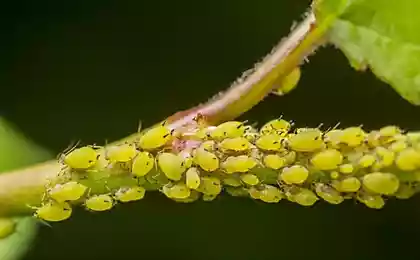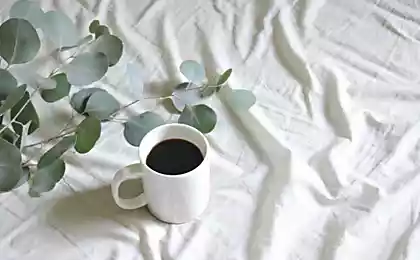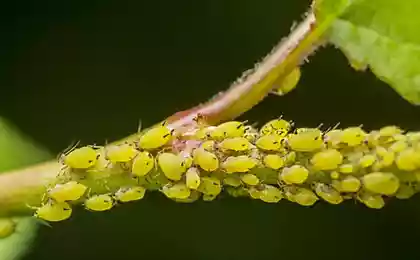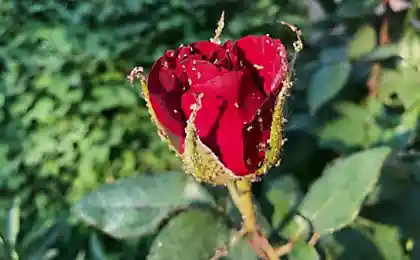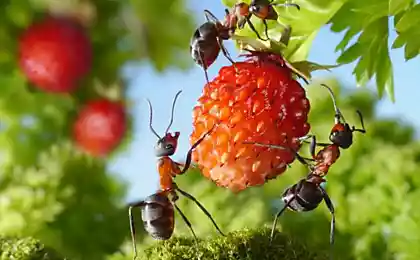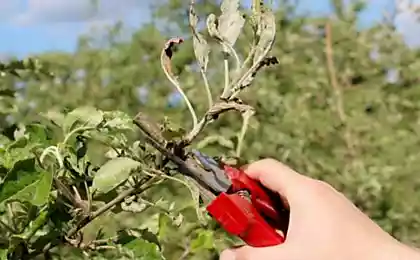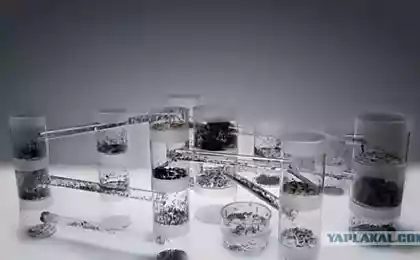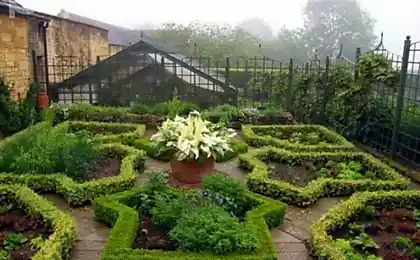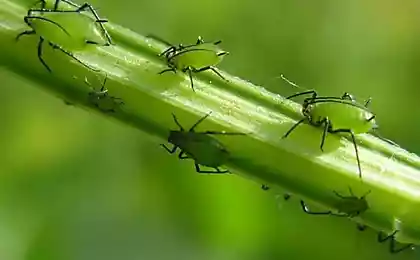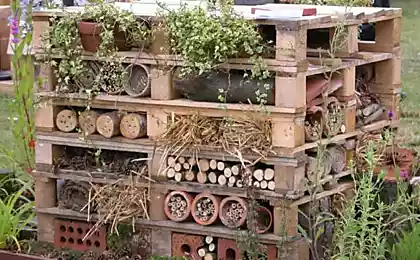1279
Folk methods of dealing with aphids
Undoubtedly, the aphid is considered by farmers to be one of the worst pests. On our sites we see many of its species. Green aphids chosen fruit trees and shrubs, roses, chrysanthemum; black — garden cornflower and legumes; cotton, cucumbers, melons and gourds, and galarita aphid species harmful to stone-fruits (especially plum), red clover and burashnikova...
They settle on leaves, stems and roots, they crawl and fly, and where no stop "wait and feed" — plants be a big problem.
What is dangerous aphids Leaf aphids quickly weakens young plants by sucking their cell SAP. At the same time it allocates more and poison, which makes the leaves curl, become deformed and die, shoots are stunted, the tops are bent. Sweet selection — waste contaminate the sheet surface, disrupt the normal life of the plant.
Besides, through the saliva of aphids are able to infect plants with harmful viruses that can cause extensive damage, especially in gardens or professional rosarian. When aphid colonies become too large, the leaves and young shoots dry up and die. The greatest harm aphid causes young seedlings of fruit trees.
If you do not use any special methods against this pest, aphids a purely natural way, without straining, giving up to 50 generations over the summer, will cause significant damage to anyone — very well kept — country site. No wonder only in the Northern hemisphere around 450 species of leaf aphid are among the most important pests of agriculture, forestry and gardening.
To deal with aphids is extremely difficult: it multiplies rapidly and continually. So you should try to get rid of her faster than she can rid us of the harvest.
That you should consider in aphid control Before you rush to the enemy, we need to understand, "where did this problem grow legs", to the right, smart approach to combating the pest.
1. Where and why do I get aphids? Aphids feed on plant SAP, piercing his skin with their proboscis. Old hard leaves her "no teeth", she needs the most tender young leaves and buds.So, the likely location of lesions are the most young parts of plants. Simply put, the tops of the bushes and the underside of the leaves. Therefore, our task is to protect the young shoots and leaves.
2. As aphids appear on the plants? It is often carried by ants. (The interaction of ants and aphids is described in detail in the article, Aphids and ants). The ratio of these small insects is very touching and cause a kind smile, which, however, quickly losing face when looking at the twisted leaves of currant and covered with parasites buds favorite colors).
So the ants need a sweet syrup, which gives the aphid feeding on plant SAP. Therefore, the ants will continually deliver on the young leaves of new scopic. Moreover, there will be more to protect them from all enemies. Therefore, our task is to separate them, to deny ants access to the aphid.
3. Who can help us in the fight against aphids? Do aphids have many natural enemies like insects and birds. In addition, there are plants and aphids will be avoided. And as you know, the enemy of my enemy is my friend ;) So our task is to find ways to bring the struggle of these friends and helpers.
4. All methods of struggle? As colonies of aphids are numerous, they affect many plants, and processing have to carry out repeatedly the use of chemical drugs will inevitably lead to the fact that the earth and plants, impregnated with poisons, sooner or later will send all of them straight to our bodies. Therefore, our task is to find the methods of struggle that will not kill us.
But these methods are there, and getting bigger, because neither science nor country folk art cannot be stopped.
Ash-soap and spraying the soap (bathing) Soap washing and spraying, the second (after the usual wash aphids from plants with a jet of water) a simple method of struggle. It costs little and works: water in any economy is available, and soap is not difficult to grate.
Recipes:
Herbal infusions Despite the fact that the vegetable infusions and decoctions are not chemicals, not to lose sight of the fact that they
But the most successful recipes of herbal extracts of the aphidsoffered by our gardeners:
30-35 g of crushed heads of onions (you can add and onion skins) to insist in 1 liter of water for 5 hours. Add 4-5 g of soap. Drain. To increase the volume of infusion to 1 liter. How to do it practically — look at the video
200 g of crushed cloves of garlic infuse for 4-5 days in 1 quart of water under the lid. Apply at a concentration of 25 ml of infusion per 10 liters of water
200 g of crushed dried leaves insist 2 days in 5 liters of water. Then bring to 10 liters. Drain.
— 100 g dry herb and inflorescences of chamomile infuse for 12 hours in 1 liter of water. Spray at a concentration of 1:3 with addition of soap at the rate of 4 g per 1 liter of solution;
— 250 grams of chamomile flowers Dalmatian (Caucasian) crushed to dust, stir in water. Spraying is performed immediately after preparation.
— 400 g of leaves and 200 g of roots of dandelions for 3-4 hours in 10 liters of water.
— 30 g of dried leaves and dandelion root infuse for 3 hours in 10 liters in 10 liters of water
Half a bucket of chopped flowers plants to fill water up to the top, leave for 2 days. Strain, add 40 g of soap per 10 liters of water.
400 g sorrel roots, pour hot water and infuse for 3 hours.
1 kg of fresh pods of chili peppers (or 300 g dry) brew day in 10 liters of water.Spray at a concentration of 1:10
1 kg of needles of Scots pine to insist for 7 days in 4 liters of water. Stir once a day. Spray at a concentration of 1:1
100 g of dried peels of any citrus fruits pour 1 liter of warm water, to insist 3 days
1 kg of potato tops (take healthy, not damaged by disease!) grind and brew 10 litres of water 3 hours. Dried or dry tops to take less — 0.8 and 0.6 kg, respectively.
Now you will see how to deal with aphids by using celandine
Herbal decoctions This method of aphid control is one of the most common. Decoctions of herbs have insecticidal, fungicidal and antifeedant properties and is very effective against insect pests.
Here are the plants that are most commonly used for cooking broths, and popular recipes of herbal decoctions against aphids:
200 g of crushed dried leaves insist night in 5 liters of water. Then bring up to 10 litres and simmer on low heat for 1.5-2 hours
5 kg of green leaves and laterals, pour 10 liters of hot water and boil for 30 minutes on low heat. Spray at a concentration of 1:3 based on 1 liter of broth 3 liters of water). Before spraying, add 30 g of soap per 10 liters of water.
100 g of fresh pods to boil for at least one hour in 1 liter of water in a sealed container. Insist 2 days, pepper to grind, the solution to drain. For spraying the concentrate is diluted 1:10, add 40 g of soap per 10 liters of solution
400 g of fresh stems and flowers (or 100 g, dry) chop, pour 1 liter of water and infuse for 1-1. 5 hours, then boil for 20-30 minutes.
Not less effective and decoctions of the Dryopteris, wormwood, tansy and rhubarb
Creative and cooking methods of dealing with aphids Sometimes the conventional product can be a great tool in the fight against plant pests. And the ingenuity of our gardeners sometimes simply admirable.
Like the previous recipe, a bottle of Coca-Cola to put on the sprayer and spray affected plants. Most likely devastating effect of this liquid on aphids due to the presence in Cola is phosphoric acid.
Here's how you can win aphids — with milk and iodine. Watch the video :)
Fumigation of trees and shrubs with smoke long been used by our grandparents and great-grandparents for protection of trees during short-term frost. Today gardeners extend the "smoky" range.
Some gardeners suggest to use to fight with aphids, these ambiguous methods as smoke from burning rubber, wiper and even cleaner gas stoves. Of course, for fruit crops, such methods are totally unacceptable. Whether or not to use them on ornamental plants — solves every man for himself. If you want to experiment, look, like fighting aphids the author of the next video
Plants are allies in the fight against the aphids Our allies in the fight against aphids are garden plants. The degree of impact on the parasite, they are divided into 2 groups:
Plants-scarers with Their volatile (volatile, odorous substances), they deter aphids. It has a bright smell of herbs — marigolds and coriander, onion and garlic, peppermint and fennel, mustard and Basil, the Dalmatian chamomile and feverfew, and lavender. These plants are recommended to put close to protected crops the edges of the beds, in the aisles or small spaces.in the home garden
Plant These attractive plants are just the opposite — attract aphids to itself, thereby distracting from the desired culture. This nasturtium and Petunia, hollyhock , and cosmos bipinnatus, kleoma and tuberous begonias, soporific poppy and beans. Tree aphids are most attracted to Linden, viburnum and Prunus. These plants are recommended to plant away from the main crops you want to protect from pests. Affected by the pest defenders then or removed from the site, or to conduct a spraying or washing.
Insects and birds are the natural enemies of aphids, the Most convenient way of dealing is to ensure that the enemy was done by someone else ;) the Strategy is necessary!
Insects That "others" can be those insects that feed on aphids:
To attract beneficial insects in the garden planted carrots, parsley, dill and other fragrant herbs. And yet — build houses for bugs!
To lure to the site the hover suggest to plant daisies. Hoverflies do not kill aphids, they feed on the pollen of daisies. But the larvae of hover flies in great quantities consume aphids, which is nearby. Therefore, by giving the hover, do not regret it.
Ground beetles will choose a nightshade and amaranth, and zlatovlaska prefer for breeding cool shady spot, covered with thickets of bracken.
Unable to place in the garden flower pots with wood shavings — they will be able to settle earwigs, which are also not averse to eat aphids.
In addition, larvae of ladybirds and lacewings can be purchased at specialty garden centers (or mail order), and then to release on the site.
Birds That especially pleases — is the aphid prey for many small birds. They feed it to their Chicks. Readily eat aphids
But! If you have already decided to enlist the aid of beneficial insects and birds, you will have to completely abandon the use phase of pesticides!
This is not a complete list of the funds that we can apply in dealing with this little pest is a parasite of aphids. Use the most suitable folk recipe, you can experiment and choose the most affordable and efficient in your opinion.
Source: www.7dach.ru
They settle on leaves, stems and roots, they crawl and fly, and where no stop "wait and feed" — plants be a big problem.
What is dangerous aphids Leaf aphids quickly weakens young plants by sucking their cell SAP. At the same time it allocates more and poison, which makes the leaves curl, become deformed and die, shoots are stunted, the tops are bent. Sweet selection — waste contaminate the sheet surface, disrupt the normal life of the plant.
Besides, through the saliva of aphids are able to infect plants with harmful viruses that can cause extensive damage, especially in gardens or professional rosarian. When aphid colonies become too large, the leaves and young shoots dry up and die. The greatest harm aphid causes young seedlings of fruit trees.
If you do not use any special methods against this pest, aphids a purely natural way, without straining, giving up to 50 generations over the summer, will cause significant damage to anyone — very well kept — country site. No wonder only in the Northern hemisphere around 450 species of leaf aphid are among the most important pests of agriculture, forestry and gardening.
To deal with aphids is extremely difficult: it multiplies rapidly and continually. So you should try to get rid of her faster than she can rid us of the harvest.
That you should consider in aphid control Before you rush to the enemy, we need to understand, "where did this problem grow legs", to the right, smart approach to combating the pest.
1. Where and why do I get aphids? Aphids feed on plant SAP, piercing his skin with their proboscis. Old hard leaves her "no teeth", she needs the most tender young leaves and buds.So, the likely location of lesions are the most young parts of plants. Simply put, the tops of the bushes and the underside of the leaves. Therefore, our task is to protect the young shoots and leaves.
2. As aphids appear on the plants? It is often carried by ants. (The interaction of ants and aphids is described in detail in the article, Aphids and ants). The ratio of these small insects is very touching and cause a kind smile, which, however, quickly losing face when looking at the twisted leaves of currant and covered with parasites buds favorite colors).
So the ants need a sweet syrup, which gives the aphid feeding on plant SAP. Therefore, the ants will continually deliver on the young leaves of new scopic. Moreover, there will be more to protect them from all enemies. Therefore, our task is to separate them, to deny ants access to the aphid.
3. Who can help us in the fight against aphids? Do aphids have many natural enemies like insects and birds. In addition, there are plants and aphids will be avoided. And as you know, the enemy of my enemy is my friend ;) So our task is to find ways to bring the struggle of these friends and helpers.
4. All methods of struggle? As colonies of aphids are numerous, they affect many plants, and processing have to carry out repeatedly the use of chemical drugs will inevitably lead to the fact that the earth and plants, impregnated with poisons, sooner or later will send all of them straight to our bodies. Therefore, our task is to find the methods of struggle that will not kill us.
But these methods are there, and getting bigger, because neither science nor country folk art cannot be stopped.
Ash-soap and spraying the soap (bathing) Soap washing and spraying, the second (after the usual wash aphids from plants with a jet of water) a simple method of struggle. It costs little and works: water in any economy is available, and soap is not difficult to grate.
Recipes:
- 300 g of soap per 10 liters of water. Can be replaced with liquid soap, then you need only 125 ml per 10 liters of water.
- 100 g tar soap diluted in 10 liters of water.
- 250-300 g of ash boiled in 10 liters of water 30 minutes before spraying, you can add 40 g of soap and you can wash the plants and just ash solution.
Herbal infusions Despite the fact that the vegetable infusions and decoctions are not chemicals, not to lose sight of the fact that they
- in strong concentrations can cause burns in plants
- can be dangerous not only for aphids but for other insects
- at least some of them poisonous to humans.
- any solutions before first use must first be validated in a limited area, and only then, convinced of the effectiveness of tools to use throughout the site
- fruit crops can be treated with decoctions and infusions during budding, after flowering and no later than 14-40 days before harvest
- crops treated with infusions is recommended before flowering and once the berries are removed
- vegetables one last time to spray the infusions can be no later than a month before the withdrawal of the fruit
But the most successful recipes of herbal extracts of the aphidsoffered by our gardeners:
30-35 g of crushed heads of onions (you can add and onion skins) to insist in 1 liter of water for 5 hours. Add 4-5 g of soap. Drain. To increase the volume of infusion to 1 liter. How to do it practically — look at the video
200 g of crushed cloves of garlic infuse for 4-5 days in 1 quart of water under the lid. Apply at a concentration of 25 ml of infusion per 10 liters of water
200 g of crushed dried leaves insist 2 days in 5 liters of water. Then bring to 10 liters. Drain.
— 100 g dry herb and inflorescences of chamomile infuse for 12 hours in 1 liter of water. Spray at a concentration of 1:3 with addition of soap at the rate of 4 g per 1 liter of solution;
— 250 grams of chamomile flowers Dalmatian (Caucasian) crushed to dust, stir in water. Spraying is performed immediately after preparation.
— 400 g of leaves and 200 g of roots of dandelions for 3-4 hours in 10 liters of water.
— 30 g of dried leaves and dandelion root infuse for 3 hours in 10 liters in 10 liters of water
Half a bucket of chopped flowers plants to fill water up to the top, leave for 2 days. Strain, add 40 g of soap per 10 liters of water.
400 g sorrel roots, pour hot water and infuse for 3 hours.
1 kg of fresh pods of chili peppers (or 300 g dry) brew day in 10 liters of water.Spray at a concentration of 1:10
1 kg of needles of Scots pine to insist for 7 days in 4 liters of water. Stir once a day. Spray at a concentration of 1:1
100 g of dried peels of any citrus fruits pour 1 liter of warm water, to insist 3 days
1 kg of potato tops (take healthy, not damaged by disease!) grind and brew 10 litres of water 3 hours. Dried or dry tops to take less — 0.8 and 0.6 kg, respectively.
Now you will see how to deal with aphids by using celandine
Herbal decoctions This method of aphid control is one of the most common. Decoctions of herbs have insecticidal, fungicidal and antifeedant properties and is very effective against insect pests.
Here are the plants that are most commonly used for cooking broths, and popular recipes of herbal decoctions against aphids:
200 g of crushed dried leaves insist night in 5 liters of water. Then bring up to 10 litres and simmer on low heat for 1.5-2 hours
5 kg of green leaves and laterals, pour 10 liters of hot water and boil for 30 minutes on low heat. Spray at a concentration of 1:3 based on 1 liter of broth 3 liters of water). Before spraying, add 30 g of soap per 10 liters of water.
- Yarrow
100 g of fresh pods to boil for at least one hour in 1 liter of water in a sealed container. Insist 2 days, pepper to grind, the solution to drain. For spraying the concentrate is diluted 1:10, add 40 g of soap per 10 liters of solution
400 g of fresh stems and flowers (or 100 g, dry) chop, pour 1 liter of water and infuse for 1-1. 5 hours, then boil for 20-30 minutes.
Not less effective and decoctions of the Dryopteris, wormwood, tansy and rhubarb
Creative and cooking methods of dealing with aphids Sometimes the conventional product can be a great tool in the fight against plant pests. And the ingenuity of our gardeners sometimes simply admirable.
- Vodka Russkaya common
Like the previous recipe, a bottle of Coca-Cola to put on the sprayer and spray affected plants. Most likely devastating effect of this liquid on aphids due to the presence in Cola is phosphoric acid.
Here's how you can win aphids — with milk and iodine. Watch the video :)
- Fumigation of tobacco smoke
Fumigation of trees and shrubs with smoke long been used by our grandparents and great-grandparents for protection of trees during short-term frost. Today gardeners extend the "smoky" range.
- Wetting essential oils with cream
- Wash a suspension of sunflower oil with water
Some gardeners suggest to use to fight with aphids, these ambiguous methods as smoke from burning rubber, wiper and even cleaner gas stoves. Of course, for fruit crops, such methods are totally unacceptable. Whether or not to use them on ornamental plants — solves every man for himself. If you want to experiment, look, like fighting aphids the author of the next video
Plants are allies in the fight against the aphids Our allies in the fight against aphids are garden plants. The degree of impact on the parasite, they are divided into 2 groups:
Plants-scarers with Their volatile (volatile, odorous substances), they deter aphids. It has a bright smell of herbs — marigolds and coriander, onion and garlic, peppermint and fennel, mustard and Basil, the Dalmatian chamomile and feverfew, and lavender. These plants are recommended to put close to protected crops the edges of the beds, in the aisles or small spaces.in the home garden
Plant These attractive plants are just the opposite — attract aphids to itself, thereby distracting from the desired culture. This nasturtium and Petunia, hollyhock , and cosmos bipinnatus, kleoma and tuberous begonias, soporific poppy and beans. Tree aphids are most attracted to Linden, viburnum and Prunus. These plants are recommended to plant away from the main crops you want to protect from pests. Affected by the pest defenders then or removed from the site, or to conduct a spraying or washing.
Insects and birds are the natural enemies of aphids, the Most convenient way of dealing is to ensure that the enemy was done by someone else ;) the Strategy is necessary!
Insects That "others" can be those insects that feed on aphids:
- hoverflies
- ladybugs (their larvae are the main enemies of aphids)
- flies survey
- lacewing
- earwigs
- riders
- ground beetles
- some wasps (Aphidius)
- predatory bugs
To attract beneficial insects in the garden planted carrots, parsley, dill and other fragrant herbs. And yet — build houses for bugs!
To lure to the site the hover suggest to plant daisies. Hoverflies do not kill aphids, they feed on the pollen of daisies. But the larvae of hover flies in great quantities consume aphids, which is nearby. Therefore, by giving the hover, do not regret it.
Ground beetles will choose a nightshade and amaranth, and zlatovlaska prefer for breeding cool shady spot, covered with thickets of bracken.
Unable to place in the garden flower pots with wood shavings — they will be able to settle earwigs, which are also not averse to eat aphids.
In addition, larvae of ladybirds and lacewings can be purchased at specialty garden centers (or mail order), and then to release on the site.
Birds That especially pleases — is the aphid prey for many small birds. They feed it to their Chicks. Readily eat aphids
- sparrows
- Chiffchaff
- willow Warbler
- Tits
- goldcrests
- wrens
- Robins-Robins
- Konoplyanka.
But! If you have already decided to enlist the aid of beneficial insects and birds, you will have to completely abandon the use phase of pesticides!
This is not a complete list of the funds that we can apply in dealing with this little pest is a parasite of aphids. Use the most suitable folk recipe, you can experiment and choose the most affordable and efficient in your opinion.
Source: www.7dach.ru
Warren Buffett has decided once again to invest in renewable energy
Nishishin—romantic castle of the Bavarian king Ludwig II
